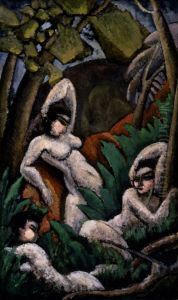Max Weber Paintings
Max Weber was a Polish-born American painter and one of the first American Cubist painters who, following an early period of figurative work, became a prominent exponent of Cubism in the United States. Born on April 18, 1881, in Białystok, then part of the Russian Empire, Weber moved to Brooklyn, New York, with his family in 1891. There, he received a traditional art education at the Pratt Institute under Arthur Wesley Dow, who was a significant influence on his early work.
Weber's artistic journey took a pivotal turn when he moved to Paris in 1905, where he lived until 1908. During this period, he was immersed in the vibrant art scene and was influenced by the works of Henri Matisse, Pablo Picasso, and the Fauves. His exposure to European modernism shaped his subsequent artistic direction.
Upon returning to America, Weber began to incorporate the Cubist style into his work. He was a pioneer in this regard, as Cubism was not yet widely accepted or understood in the United States. His paintings from this period are characterized by fragmented forms, geometric abstraction, and a focus on the structure of objects rather than their outward appearance.
Throughout his career, Weber also explored other styles and themes. After his initial Cubist phase, his work became more abstract and sometimes incorporated elements of Surrealism and Expressionism. He was interested in spiritualism and theosophy, which also influenced his art.
In addition to painting, Weber was also a teacher and writer. He taught at the Clarence H. White School of Photography in New York and later at the Art Students League. Weber's essays and poetry reflect his thoughts on art and his philosophy of life; his written works were another facet of his creative expression.
Max Weber's contribution to American modern art was significant. His work was part of the movement that helped introduce and establish avant-garde European art styles in the United States. Weber's art evolved over his lifetime, reflecting the dynamic changes in American art during the first half of the 20th century. He died on October 4, 1961, in Great Neck, New York, leaving behind a legacy that continues to be appreciated for its innovation and breadth.
